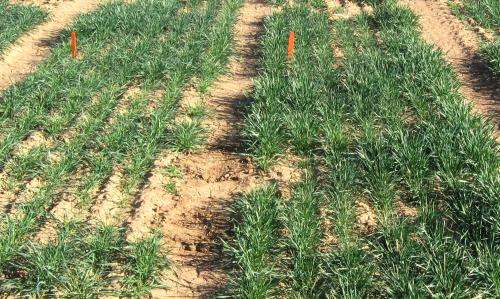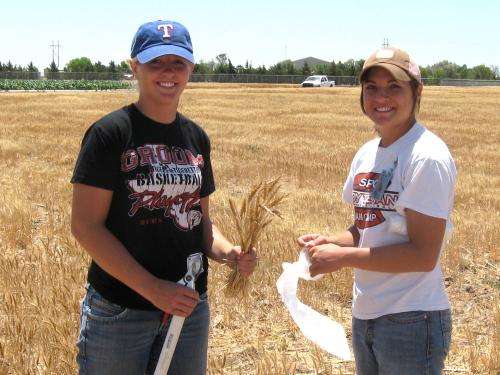High yield, water efficiency of drought tolerant wheat due to higher biomass

Drought tolerance in wheat has been increased through breeding over the years, but a group of Texas A&M AgriLife Research scientists in Amarillo wanted to determine what plant physiological characteristics were making the biggest difference.
The results of this study, "Yield Determination and Water-Use Efficiency of Wheat Under Water-Limited Conditions in the U.S. Southern High Plains," will be published in the Crop Science journal in January.
The study was completed by the AgriLife Research team of Dr. Qingwu Xue, crop stress physiologist; Dr. Jackie Rudd, wheat breeder; Dr. Shuyu Liu, small grains geneticist; Kirk Jessup, research associate; Ravindra Devkota, associate research scientist; and Dr. James Mahan, U.S. Department of Agriculture-Agricultural Research Service plant physiologist in Lubbock.
Funded in part by the Ogallala Aquifer Program and Texas Wheat Producers Board, the study featured a two-year field experiment with 10 different wheat varieties. The varieties were grown under dryland and irrigated conditions, looking primarily at yield determination and water-use efficiency.
Drought is the most important stress for reducing wheat yield and water-use efficiency in the southern High Plains states, Xue said. Adoption of varieties with higher yield and water-use efficiency under drought conditions is critical in the area.

"The bottom line is the newer, drought-tolerant varieties have higher grain yield than the relatively older varieties, but we wanted to know what was really determining the yield under drought," he said.
"Under water-limited conditions, wheat yield is determined by above-ground biomass at maturity and harvest index. Biomass is made up of stems, leaves and heads; while harvest index is the percentage of the biomass that is grain.
"What we have found is that yield under drought was more correlated to biomass production than harvest index," Xue said. "Therefore, the ability to produce higher biomass is important for dryland wheat production."
The study also showed biomass at flowering – before grain production – significantly contributed to higher yield under drought, he said. Yield, heads per square foot and harvest index were correlated to head, stem and total dry weights per unit area at flowering.
For dryland wheat, translocation of carbohydrates stored in the stems before flowering to the developing grain also contributed to yield. This is particularly important during grain fill at the end of the season when the green leaf area is decreasing. The amount of translocation was directly related to individual stem dry weight at flowering.
"The results of this study indicated that stem dry weight at flowering is an important trait for high yield under drought in the southern High Plains environment," he said.
The team is currently summarizing other studies to investigate what contributes to higher biomass in wheat under drought.
"Our initial results indicated the higher biomass of drought tolerant varieties is related to their ability to efficiently extract water from the soil," Xue said.
More information: "Yield Determination and Water Use Efficiency of Wheat 1 under Water-limited Conditions in the U.S. Southern High Plains." Q. Xue, J. C. Rudd, S. Liu, K. E. Jessup, R. N. Devkota, and J. R. Mahan. Crop Science. 20 Aug. 2013; DOI: 10.2135/cropsci2013.02.0108
Provided by Texas A&M University




















